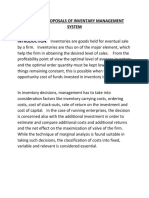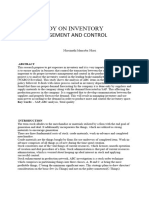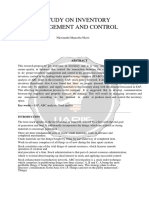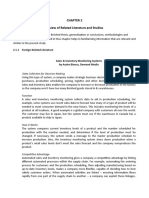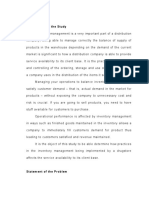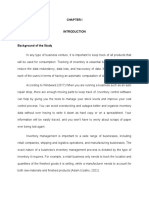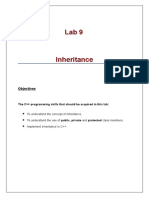Running Head: Inventory Management 1
Running Head: Inventory Management 1
Uploaded by
samuel nziokaCopyright:
Available Formats
Running Head: Inventory Management 1
Running Head: Inventory Management 1
Uploaded by
samuel nziokaOriginal Description:
Original Title
Copyright
Available Formats
Share this document
Did you find this document useful?
Is this content inappropriate?
Copyright:
Available Formats
Running Head: Inventory Management 1
Running Head: Inventory Management 1
Uploaded by
samuel nziokaCopyright:
Available Formats
Running head: INVENTORY MANAGEMENT
Inventory management
Name
Institution
Date
INVENTORY MANAGEMENT
Procter and Gamble and Pepsi Company have been chosen as the companies of choice for
the paper. Procter and Gamble and Pepsi Company are two major companies that have been
considered as leaders in their respective industries that they operate in. Procter and Gamble
produces household goods meant for beauty while Pepsi Company is a leading company that
produces beverages for its customers globally. Analysis of both companies will provide an
insight on inventory management, thereby providing important information on inventory
decisions that similar organizations need to make in order to attain their goals and objectives.
Characteristics of the different types of inventories
Pepsi and Proctor and Gamble use coherent frameworks in making their inventory
decisions, which reduces their inventory surpluses. In analysis of Pepsi Company, the company
has been able to introduce the Economic order (EOQ) in order management. Through this
structure in inventory management, it has been possible for the company to reduce its costs in
ordering. Analysis of the company has also shown that Pepsi Company uses ABC inventory
control system. Through this system, the company has been able to maintain its inventories by
prioritizing the goods that have the highest value.
Proctor and Gamble has also created an inventory control system that is based on a
spreadsheet. Through this system, the company is in a position to track and organize data, which
enables the company to control its inventory and manage the supply chains. Proctor and Gamble
uses Consumer-Driven Supply Network (CDSN) in being able to generate its sales. However,
Pepsi uses just-in-time (JIT) in being able to synchronize the deliveries that it makes (Visconti,
2012).
INVENTORY MANAGEMENT
In evaluating the features of the inventories for both Pespsi and Proctor and Gamble
companies, the main similarity is the large stocks especially during manufacturing, selling
period, work-in-process inventories during manufacturing and the goods along the line to the
point of sale. In Pepsi Company, operations surrounding inventory include documenting the
amount of the raw products in the balance sheet, data that is used in manufacturing and
production phases (Stoddard, 2002). From 2011 to 2013, there has been a decline in the raw
materials that were documented in the balance sheet and the merchandise date. Analysis of the
features of the inventory system at Pepsi has also shown that there is a decline in the amount if
goods that the company is holding and are available for sale (Visconti, 2012).
The features of the inventory management system were different at Proctor and Gamble.
The amount of raw material in the company were considered low in as from 2011 to 2013 but
increased as from 2013 to 2014. Analysis of the work in process for the company showed that
both companies were similar as from 2011 to 2013 but it later reduced in 2013 to 2014 for
Proctor and Gamble. The finished goods were able to increase as from 2012 to 2013 but there
was a slight decrease 2013 to 2014 (Visconti, 2012).
Analysis of design concepts integration for products and services
Procter and Gamble provides branded household products to its consumers globally. The
company uses membership club stores, among other stores within the neighborhood of the
consumers. There are different specifications for products of the company. When observing its
products such as Mountain Dew Color, Slice Color Aquafina, Miranda, 7up, and Pepsi, it is
possible to observe that all these products are different. This design involves recruitment process
INVENTORY MANAGEMENT
that identifies the different tastes and preferences by customers. Through such a process, there is
more production, which means that there will be more profits (Stoddard, 2002).
The role that inventory plays in the companys performance, operational efficiency, and
customer satisfaction
There are a number of roles that management of inventory plays in the performance,
customer satisfaction, and operational efficiency within a business organization. Through
inventory management, it is possible to predict the process due to the need of manning raw
materials, before making a decision on scheduling during procession stage. Inventory can be
considered as a shock absorber that exists between planning, scheduling, and processing (Muller,
2003). IT is also important to note the importance of the inventory list in estimating the
fluctuations in demand for the products that have been manufactured. Even when the inventory
manager does not have knowledge on the stock needed at some point in time, it is important to
note that the customer has always been satisfied. Such times occur when resources are scarce,
which means that the production process is usually slowed.
Inventory is an important feature in protection of pricing strategies. This is mainly
because, the purchase of the needed material in time is important in reducing the effects caused
by inflation. That therefore means that buying material in advance at reasonable prices helps in
maintaining prices for goods. The use of inventories by business organizations ensures that a
large scale buyer benefits from discounts that have been made available. This is effective since it
saves on costs of ordering cost since buying goods in large quantities attracts low prices as
compared to buying goods in low quantities.
INVENTORY MANAGEMENT
Different types of layouts and their importance to the enterprise manufacturing or service
operations
Both Proctor and Gamble can be considered to display similar layouts in production
cycles. These layouts have been identified as Depth of the product line and Product mix WIDTH.
In both layouts, there is variety of aspects such as color taste, consistency, among others that are
considered. The importance of these layouts is the improvement in efficiency of space needed in
manufacturing, cutting on production delays and general improvement of the quality of products
(Muller, 2003).
Metrics to evaluate supply chain performance and improvements to the design and
operations of the supply chains
The first metric used is the categorical system where the buyer is at will to make a choice
on the favorable qualities. The categorical system is effective in the aspect that the buyer can
assign a rating of their choice based on their experience. This helps in determining the vendor
that has highest ratings. Supplier measurement is usually subjective, which creates a big need for
independent customers to assign ratings in attaining quantity data (Lambert, 2001).
The other used is the evaluation involves being able to select and assign the weight of the
attributes due to their importance performance of the company. This is followed by decision
from the administration of the company where the weight attained is multiplied by the score of
performance and the products totaled. Such calculations reduce subjectivity and are used in
making important decisions affecting the company`s operations (Decker, 1999).
Improving the inventory management
INVENTORY MANAGEMENT
One of the ways used in improving inventory management is the consideration of the
optimization tools used in inventory, which enables easy evaluation of the current network in the
inventory practices. . The other that can be used in improving inventory management is the
employment of business solutions that are based on real-time analytics. This is better as
compared to the use of spreadsheet, which means that all operations could be made under one
platform. This involves gathering similar data and being able to conduct financial analysis and
supply chain decisions that lead to immediate results. The third strategy would be integration of
current technology that identifies the use of mobile devices. Mobile devices allow being able to
get instant data on inventory management, which helps in making better inventory decisions.
Through such improvements, it will be possible to attain the goals and objectives of the
organization (Bose, 2006).
References
INVENTORY MANAGEMENT
Bose, D. C. (2006). Inventory management. New Delhi: Prentice Hall of India.
Decker, C. L. (1999). Winning with the P&G 99: 99 principles and practices of Procter &
Gamble's success. New York: Pocket Books.
Lambert, D. and Pohlen, T. (2001). Supply Chain Metrics. The International Journal of Logistics
Management, 12 (1), 1 19.
Muller, M., & Amacom. (2003). Essentials of inventory management. New York, N.Y: American
Management Association.
Stoddard, B. (2002). The encyclopedia of Pepsi-Cola collectibles. Iola, WI: Krause Publications.
Visconti, L. (2012). Corporate Diversity: How P&G values Drive Innovations.
You might also like
- Research Proposal On Warehouse EffeciencyDocument10 pagesResearch Proposal On Warehouse EffeciencyAmna Hayat80% (5)
- Engine F4CE9484 - F4HE9687 NEF Tier 3 AgricultureDocument6 pagesEngine F4CE9484 - F4HE9687 NEF Tier 3 AgricultureLuis Alberto Castillo Nieto50% (4)
- Osho-Hidden Mysteries #6 AstrologyDocument11 pagesOsho-Hidden Mysteries #6 AstrologyramachariNo ratings yet
- A Study On InventoryDocument9 pagesA Study On Inventorynkosinathidlamini437No ratings yet
- A Study On Inventory Management and Control Thesi ProjectDocument9 pagesA Study On Inventory Management and Control Thesi Projectnkosinathidlamini437No ratings yet
- Inventory Management and Organizational Performance (Study of Dansa Food Limited)Document25 pagesInventory Management and Organizational Performance (Study of Dansa Food Limited)Lubna WaheedNo ratings yet
- Inventory Management in LiberyDocument101 pagesInventory Management in LiberySamuel DavisNo ratings yet
- Operations Management at Kudler Foods: Business ProcessesDocument5 pagesOperations Management at Kudler Foods: Business Processestechankit1234No ratings yet
- Nkosinathi ReportDocument9 pagesNkosinathi Reportnkosinathidlamini437No ratings yet
- Achievements and Awards If AnyDocument40 pagesAchievements and Awards If AnyMohamed RiyasNo ratings yet
- A Study On Inventory Management and Control: Pratap Chandrakumar. R Gomathi ShankarDocument9 pagesA Study On Inventory Management and Control: Pratap Chandrakumar. R Gomathi Shankarshravasti munwarNo ratings yet
- Automated Inventory Control System (SATELLITE)Document47 pagesAutomated Inventory Control System (SATELLITE)Ajewole Eben TopeNo ratings yet
- Study On Tools and Techniques of Inventory Management - An OveviewDocument61 pagesStudy On Tools and Techniques of Inventory Management - An OveviewAhamed IbrahimNo ratings yet
- Computerized Inventory System of The Naning Pharmacy: Irene P. Albanez Rea E. Lacson Cristito O. LizadaDocument11 pagesComputerized Inventory System of The Naning Pharmacy: Irene P. Albanez Rea E. Lacson Cristito O. LizadaRica Marquez LloritoNo ratings yet
- Q1Document9 pagesQ1jiandagan168No ratings yet
- Monginise Inventory ManagementDocument36 pagesMonginise Inventory ManagementTejNaikNo ratings yet
- Ijrpr2914 A Study of Inventory Management TechniqueDocument3 pagesIjrpr2914 A Study of Inventory Management TechniqueStatus LoverNo ratings yet
- Sample Case AnalysisDocument16 pagesSample Case AnalysisAlthon JayNo ratings yet
- Additional Readings in Product Service DesignDocument4 pagesAdditional Readings in Product Service DesignAlexis MoralinaNo ratings yet
- Case EOQDocument12 pagesCase EOQWahyutri IndonesiaNo ratings yet
- Towards Decision Analytics in Product Portfolio Management: Research Open AccessDocument25 pagesTowards Decision Analytics in Product Portfolio Management: Research Open AccessJeroen van ZutphenNo ratings yet
- POMDocument64 pagesPOMvignesh. viswanathanNo ratings yet
- Mo A2Document19 pagesMo A2Thùy Linh NguyễnNo ratings yet
- Product CompanyDocument9 pagesProduct CompanyNhi NhiNo ratings yet
- URATEXDocument6 pagesURATEXAnonymous pHkWpIRrNo ratings yet
- A Literature Review On Lot Sizing: G. Shanti Priya Jayakar, V.V.D. Sahithi, Dr. C.S.P. Rao, Dr. M. Srinivasa RaoDocument4 pagesA Literature Review On Lot Sizing: G. Shanti Priya Jayakar, V.V.D. Sahithi, Dr. C.S.P. Rao, Dr. M. Srinivasa RaokaruniaNo ratings yet
- Inventory Control in Sugar MillsDocument5 pagesInventory Control in Sugar MillsBhuvan XpressNo ratings yet
- Revisi PPT2-Design of Goods and ServicesDocument52 pagesRevisi PPT2-Design of Goods and ServicesAbdul GhoniNo ratings yet
- Development of Kpis For Assessing The Internal Logistics of Univeg'S WarehouseDocument10 pagesDevelopment of Kpis For Assessing The Internal Logistics of Univeg'S WarehouserednetijNo ratings yet
- CHAPTER 2 Review of Related Literature ADocument9 pagesCHAPTER 2 Review of Related Literature AChristian Rey HinayNo ratings yet
- Food Product Development ProcessDocument15 pagesFood Product Development ProcessAdil Anwar0% (1)
- Effects of InventoryDocument15 pagesEffects of InventoryAdrian Andrade PabalateNo ratings yet
- Drugstores ImradDocument27 pagesDrugstores ImradDick Jefferson PatingNo ratings yet
- Analysis of The Role of Capacity ManagemDocument3 pagesAnalysis of The Role of Capacity ManagemNowrin NNo ratings yet
- Cost Reduction Strategies and Performance of Supermarket Stores in Port Harcourt February, 2019Document66 pagesCost Reduction Strategies and Performance of Supermarket Stores in Port Harcourt February, 2019ruthNo ratings yet
- Annexure IiDocument8 pagesAnnexure IirsureshyadavNo ratings yet
- A Study On The Effects of Inventory Management On The Performance of The Procurement Function of Sugar Manufacturing CompaniesDocument8 pagesA Study On The Effects of Inventory Management On The Performance of The Procurement Function of Sugar Manufacturing CompaniesRabinarayan MandalNo ratings yet
- Auto Repair Shop Inv MNGTDocument23 pagesAuto Repair Shop Inv MNGTJay ArNo ratings yet
- Application of Erp in Different SectorsDocument3 pagesApplication of Erp in Different SectorsRida JawadNo ratings yet
- Week 4 OPS510 Paper (Portfolio)Document18 pagesWeek 4 OPS510 Paper (Portfolio)Diahann ColemanNo ratings yet
- Industrial Training Theoretical Relevance.Document4 pagesIndustrial Training Theoretical Relevance.Nur Amierah ZulkifliNo ratings yet
- Vijin Project FinalDocument106 pagesVijin Project FinalVijin v r100% (2)
- How Forecasting PharmaDocument5 pagesHow Forecasting PharmadebchakcseNo ratings yet
- Q.1 Meaning & Nature of Operation Management? Explain Product Design & Process Design..?Document14 pagesQ.1 Meaning & Nature of Operation Management? Explain Product Design & Process Design..?Pooja RajputNo ratings yet
- Operations ManagementDocument19 pagesOperations Managementmaster pieceNo ratings yet
- Fall 2022-2023 - Engineering Management - Chapter 2 - Competitiveness and ProductivityDocument36 pagesFall 2022-2023 - Engineering Management - Chapter 2 - Competitiveness and Productivityvajojo8727No ratings yet
- Unit Code: Bbm3216 Unit Title: Supplies Quality Management CAT 1& 2Document4 pagesUnit Code: Bbm3216 Unit Title: Supplies Quality Management CAT 1& 2Abdiladif DahirNo ratings yet
- PPT2-Design of Goods and ServicesDocument51 pagesPPT2-Design of Goods and ServicesIka FitriNo ratings yet
- End Term OF Strategic Cost Management: AssignmentDocument13 pagesEnd Term OF Strategic Cost Management: AssignmentRajshree soniNo ratings yet
- A Comparative Analysis of Impact of Inventry Valuation Methodin The Management of The Manufacturing CompanyDocument33 pagesA Comparative Analysis of Impact of Inventry Valuation Methodin The Management of The Manufacturing CompanyBalogun Felix AyindeNo ratings yet
- Inventory MGT ProjectDocument98 pagesInventory MGT ProjectBenjamin AkosaNo ratings yet
- Theme 5 Management Science and Financial Management Course GuideDocument48 pagesTheme 5 Management Science and Financial Management Course Guidedanielnebeyat7No ratings yet
- Rdad 005Document28 pagesRdad 005axborottexnologiyalari0No ratings yet
- Inventory Mana Sujana Metal 21Document35 pagesInventory Mana Sujana Metal 21MOHAMMED KHAYYUMNo ratings yet
- Assignment 1Document5 pagesAssignment 1eng.hfk06No ratings yet
- Impact of Physical Fitness in Enhancing Students Academic PerformanceDocument68 pagesImpact of Physical Fitness in Enhancing Students Academic PerformanceD-Blitz StudioNo ratings yet
- Managing Product and Services: OperationsDocument4 pagesManaging Product and Services: OperationsPhilip SabadiNo ratings yet
- Final ThesisDocument82 pagesFinal ThesisGemma Capilitan BoocNo ratings yet
- Last One FileDocument45 pagesLast One FilekirubelNo ratings yet
- Manufacturing Secret : Product Development and Intelligent Manufacturing For Flexible Automation With Odoo 17: odoo consultations, #1.1From EverandManufacturing Secret : Product Development and Intelligent Manufacturing For Flexible Automation With Odoo 17: odoo consultations, #1.1No ratings yet
- Morphological Based Technique For Image Segmentation: Twhaw@mmu - Edu.my Loges@mmu - Edu.myDocument26 pagesMorphological Based Technique For Image Segmentation: Twhaw@mmu - Edu.my Loges@mmu - Edu.myBarış BayramNo ratings yet
- Mindmatters, A Whole-School Approach Promoting Mental Health and WellbeingDocument8 pagesMindmatters, A Whole-School Approach Promoting Mental Health and WellbeingMohamed Amine ChenguitiNo ratings yet
- Ingles AA2Document3 pagesIngles AA2Rosa AmesquitaNo ratings yet
- TP - Penology & Victimologgy - Jan-May-2022Document13 pagesTP - Penology & Victimologgy - Jan-May-2022sachet12No ratings yet
- NRT 5 Code A Oym Batch Que Paper @cet - Jee - NeetDocument125 pagesNRT 5 Code A Oym Batch Que Paper @cet - Jee - Neetamanrana98128No ratings yet
- Algorithmic ThinkingDocument24 pagesAlgorithmic Thinkingsoumya jNo ratings yet
- 2 CS2301 - Software EngineeringDocument2 pages2 CS2301 - Software EngineeringDinesh KumarNo ratings yet
- Calculate Density of A PowderDocument6 pagesCalculate Density of A PowderPrathyusha RamadurgamNo ratings yet
- Test Report of 220kV Bus Bar SystemDocument8 pagesTest Report of 220kV Bus Bar SystemmmsaNo ratings yet
- Analog and Digital ElectronicsDocument111 pagesAnalog and Digital ElectronicsShiva CharanNo ratings yet
- Rongalit ST LiqDocument11 pagesRongalit ST LiqMayank DhawanNo ratings yet
- Course Description G6Document6 pagesCourse Description G6KISAKYE ANTHONYNo ratings yet
- Kubota V2203-M-BG SpecificationsDocument21 pagesKubota V2203-M-BG SpecificationsMillington Mambwe100% (2)
- Theoretical Framework and ParadigmDocument4 pagesTheoretical Framework and Paradigmangelu abionNo ratings yet
- Critical Rev 2nd AsgnDocument4 pagesCritical Rev 2nd AsgnAmna KhalidNo ratings yet
- Modal Verbs in Legal EnglishDocument4 pagesModal Verbs in Legal EnglishАнастасія ЛучаніноваNo ratings yet
- Timing of Events Through Vimshottari Dasha and Transit of Planets...Document4 pagesTiming of Events Through Vimshottari Dasha and Transit of Planets...nmremala100% (1)
- Laplace Transform Note 6Document16 pagesLaplace Transform Note 62133MANAS PARABNo ratings yet
- Statement MAY2024 4935585162Document3 pagesStatement MAY2024 4935585162Yamuna D RNo ratings yet
- Das Et Al., 2009Document12 pagesDas Et Al., 2009Srija sagiNo ratings yet
- Pulse ModulationDocument74 pagesPulse ModulationAnvesh MagantiNo ratings yet
- On Marginal Allocation KTHDocument7 pagesOn Marginal Allocation KTHJohnny OnthespotNo ratings yet
- TTTDocument11 pagesTTTaust daliNo ratings yet
- Segura Perez PAF I2Document3 pagesSegura Perez PAF I2Yesimar segura perezNo ratings yet
- Clay Tiles Shop Drawing - SDDocument1 pageClay Tiles Shop Drawing - SDAhmed MohamedNo ratings yet
- Silabus AI 1Document7 pagesSilabus AI 1Aisyah Nadiatul HikmahNo ratings yet
- Objectives: The C++ Programming Skills That Should Be Acquired in This LabDocument5 pagesObjectives: The C++ Programming Skills That Should Be Acquired in This Labstudent wwNo ratings yet
- DOM Lab Manual Regulation 2017Document100 pagesDOM Lab Manual Regulation 2017RakheshNo ratings yet
- A Practical Method For Calculating Largest Lyapunov Exponents From Small Data SetsDocument18 pagesA Practical Method For Calculating Largest Lyapunov Exponents From Small Data Setsgaminster6935No ratings yet


